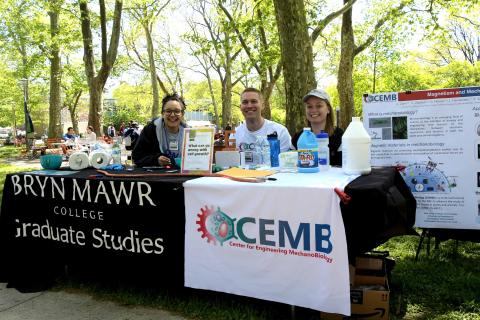Paying it Forward
Andy Clark, Ph.D. '22 on mechanobiology, medical physics, and inspiring future physicists.

On May 13, 2022, Andy Clark crossed the Bryn Mawr stage to receive his Ph.D. in physics, as well as a Mary Patterson McPherson Award for Excellence. Clark was active on campus as co-chair of the Graduate Student Association and graduate representative to the Board of Trustees. He also created outreach projects to make physics more accessible to area schoolchildren.
Why did you choose Bryn Mawr for graduate school?
I met with [Xuemei] May Cheng, who became my research advisor, and her work was very close to what I did in undergrad. I also liked her as a person, and I knew Bryn Mawr was a tight-knit physics department. I was a little nervous of going to a bigger school and getting lost in the mix.
How did your research progress at Bryn Mawr?
I really dove into a new field. May got a research grant a year after I joined her lab in an emerging field called mechanobiology. The grant funded a multi-institutional center—the Center for Engineering MechanoBiology—that brought together physicists, biologists, cell biologists, biomedical engineers, and mechanical engineers to look at new ways to do things. Among the center’s research areas was understanding how cells respond to dynamic mechanical cues in their environment and creating materials that can systematically study that. Cells behave very differently on soft substrates than on stiff substrates. If they’re on something like Jell-O they behave one way, but if you culture them on glass, they behave very differently.
What’s next for you?
My research at Bryn Mawr, especially the biomedical engineering–focused research, confirmed that medical physics is where I want to be. You can either go into therapy or imaging. The main focus for therapy is the treatment of tumors through radiation. The radiologist knows how much radiation they want to treat a tumor with, and the medical physicist makes sure the tumor gets that amount of radiation with minimal side effects to surrounding regions. I enjoy lab work, but I like a mix of things, working with people, working with instrumentation, and doing research. Medical physics really is all three of those.
Why did you become involved with outreach?
During graduate school I began to think about how I could give back to the community and expose younger kids to science. There’s been a lot of research in physics education that shows that it’s in middle school that kids lose any drive to do science. They write it off as something they don’t think they’re smart enough to do, or just don’t think is an option.
We began to develop a program to bring students from Eisenhower Middle School in Norristown to Bryn Mawr and show them the labs, have a panel discussion, and have them talk to physics graduate students about pursuing college and what we do on a daily basis. We were scheduled for March 24, 2020, right when the pandemic hit. We did it remotely on Zoom, and the students really seemed to like it. We also did an all-day event at Clark Park in West Philadelphia, where probably 600 people showed up for science demos. It was an ideal age group, with a lot of middle school children, some high school, and even some elementary school students.
It’s a lot of fun to hopefully inspire these kids. They’re going to be the future of physics someday, and we really need their ideas.
Published on: 08/09/2022